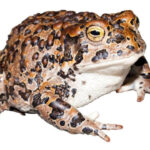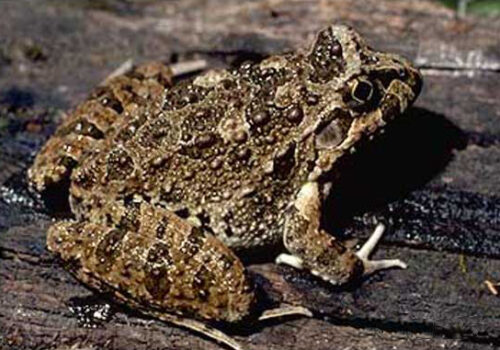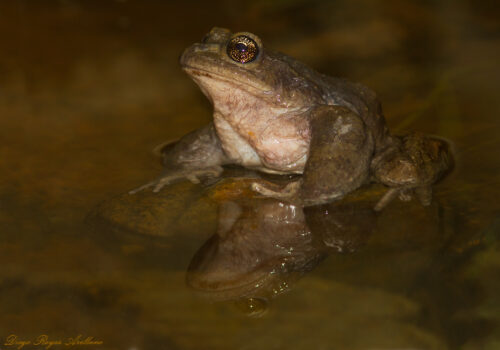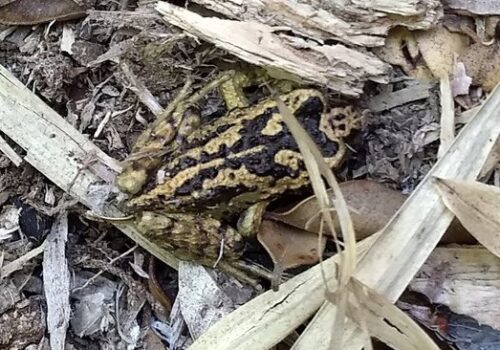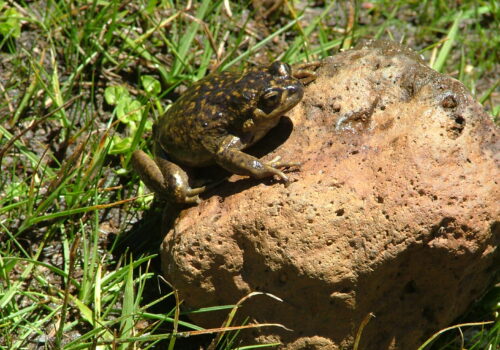- Alsodes Tumultuosus: Unearthing the Secrets of Chile's Elusive Mountain Frog
- Taxonomy and Classification
- Natural Habitat: Life Amidst the Mountains and Forests
- Physical Characteristics: A Frog Shaped by Mountains
- Behavior and Life Cycle: Resilience and Adaptation
- Ecological Role: Guardian of Stream Ecosystems
- Threats and Conservation Status: A Frog at the Crossroads
- Cultural and Scientific Significance
- Conclusion: Advocating for Alsodes tumultuosus
Alsodes Tumultuosus: Unearthing the Secrets of Chile’s Elusive Mountain Frog#
Nestled deep within the misty foothills and hidden valleys of Chile, an extraordinary amphibian clings to survival amidst cold streams, lush vegetation, and mountainous terrains. Meet Alsodes tumultuosus, an elusive species of frog whose understated appearance belies a rich tapestry of behaviors and ecological significance. Known within scientific circles by its crisp Latin nomenclature and among local herpetologists as the “Tumultuous Spiny-chest Frog,” this species has found a delicate equilibrium within South America’s temperate ecosystems.
With its cryptic habits and intriguing adaptations, Alsodes tumultuosus represents a fascinating story of evolutionary tenacity, ecological balance, and scientific wonderment. Its very existence sheds light on the intricacies of life in high-altitude habitats, offering essential insights into climate health, biodiversity trends, and conservation priorities. Join us on an immersive exploration into the hidden life of Alsodes tumultuosus, journeying through its secretive world, discovering how it thrives, understanding the pressures it faces, and appreciating why its conservation is imperative.
Taxonomy and Classification#
Alsodes tumultuosus belongs to the family Alsodidae, a group native to South America and characterized by their robust bodies and unique aquatic adaptations. Closely related amphibians within the Alsodes genus share many defining features, yet Alsodes tumultuosus stands distinctly apart in ecological preferences, behavioral traits, and subtle morphological differences.
This genus includes approximately 18 extant species, all confined primarily to southern and central Chile, with some populations extending into Argentina. Alsodes tumultuosus, first described scientifically by Lynch in 1978, offers crucial insight into the evolutionary and biogeographical processes that shaped amphibian diversity in southern South America.
Natural Habitat: Life Amidst the Mountains and Forests#
Range and Distribution#
The distribution of Alsodes tumultuosus is primarily confined to south-central Chile, especially within regions such as Biobío, Araucanía, and Los Ríos. Here, the species carves its ecological niche within cool mountainous streams, boggy wetlands, and damp temperate forests. Its precise habitat choice underscores an intricate relationship between amphibians and their environment—specifically, cool, humid, and stable habitats that have shaped this frog’s unique adaptations.
Habitat Preferences and Environmental Interactions#
Alsodes tumultuosus depends significantly on riparian habitats. Typically, these frogs gravitate toward pristine, fast-flowing mountain streams, bordered by moss-covered rocks and lush understory vegetation. Within this terrain, they find refuge, food sources, and breeding grounds—each segment of the habitat essential for their survival.
The delicate microclimates these frogs inhabit often feature stable temperatures, sufficient moisture, and ample coverage from predators. Alsodes tumultuosus is remarkably sensitive to environmental fluctuations, demonstrating its potential as an ecological indicator, warning early of disturbance or climatic shifts.
Physical Characteristics: A Frog Shaped by Mountains#
Physically, Alsodes tumultuosus possesses fascinating adaptations that harmonize perfectly with its chosen habitat. This medium-sized amphibian typically ranges from 40 to 55 millimeters in length—a modest size allowing easy concealment among leaf litter and moss.
The frog’s coloration offers effective camouflage, with individuals exhibiting muted shades of olive, gray, dark brown, and occasionally subtle reddish tints. Patterns are typically indistinct, blending impeccably with surrounding rock, mud, or decaying vegetation, protecting them from aerial and terrestrial predators.
A notable trait among males is the presence of small, thorny keratinized spines on their chest and forelimbs, giving them the colloquial name, the “Tumultuous Spiny-chest Frog.” These spines are likely used in territorial combats between competing males during the breeding period. Additionally, robust hind legs grant Alsodes tumultuosus considerable agility, allowing swift evasion when threatened and adapting well to rocky terrain and turbulent water currents.
Behavior and Life Cycle: Resilience and Adaptation#
Diet and Feeding Habits#
Alsodes tumultuosus predominantly feeds on a wide array of insects, arachnids, and other small invertebrates abundant in its moist, sheltered habitat. Given its typically nocturnal activity, the frog relies heavily on stealth, patience, and surprise, lunging swiftly upon prey items that venture close.
When active, these frogs skillfully navigate their habitat, performing careful, deliberate movements punctuated by sudden strikes upon prey. A keen sense of vision and vibration detection helps Alsodes tumultuosus effectively hunt in low-light environments.
Breeding and Reproduction#
The reproduction of Alsodes tumultuosus takes place in the turbulent yet crystal-clear mountain streams of its home region. Breeding generally occurs during periods of increased rainfall, spanning late spring into summer. During these months, males congregate at breeding sites, issuing distinctive, melodious mating calls that resonate clearly over rushing water.
After mating, females lay clusters of eggs securely attached to submerged vegetation or under sheltered crevices. As tadpoles hatch and grow, they navigate carefully among underwater surfaces, grazing on algae and aquatic microorganisms until metamorphosis into juvenile frogs. This entire life cycle intimately connects Alsodes tumultuosus to its aquatic environment, illustrating the undeniable importance of habitat conservation for this amphibian’s continued existence.
Ecological Role: Guardian of Stream Ecosystems#
Amphibians like Alsodes tumultuosus are critical indicators of environmental quality, reflecting habitat health and providing early warnings of declining ecosystem conditions. By feeding voraciously on insects and serving as prey to birds, snakes, and mammals, Alsodes tumultuosus occupies a crucial ecological niche within the regional food web.
Additionally, their tadpoles play a vital role in stream health, controlling algae growth, circulating nutrients, and supporting the stable structure of stream micro-ecosystems. The disappearance of such a species would deeply disturb environmental balance, rippling outward and impacting other organisms reliant upon these streams.
Threats and Conservation Status: A Frog at the Crossroads#
Population Pressures#
Alsodes tumultuosus, like many amphibian species globally, faces escalating threats linked to human activities. Significant habitat loss and fragmentation, mainly caused by logging, agriculture, plantations, and urban expansion, threaten the streams and forests that comprise the frog’s preferred habitats.
Additionally, climate change poses particularly concerning risks, disturbing the sensitive hydrological cycles and temperature regulation in stream corridors vital for the species’ survival. Emerging fungal diseases, notably chytridiomycosis, also represent significant risks, contributing to global amphibian declines and noting increasing concern regionally.
IUCN Conservation Status#
Recognizing its vulnerability, the International Union for Conservation of Nature (IUCN) currently lists Alsodes tumultuosus as Vulnerable. Protected areas and designated habitats within national parks serve as critical last refuges; however, more proactive conservation strategies are necessary to ensure the frog’s long-term preservation.
Active management, habitat restoration, public education, and research efforts are vital components required to safeguard the species’ future, prioritizing ecosystem connectivity and habitat integrity.
Cultural and Scientific Significance#
Within its native Chilean range, Alsodes tumultuosus subtly but distinctly enriches local biodiversity and regional culture. While traditional folklore rarely singles out this elusive species, its importance resonates beyond cultural awareness—engaging local communities with conservation ideals and ecosystems protection initiatives.
From a scientific perspective, Alsodes tumultuosus serves as a key model species, vital for studying amphibian adaptations to high-altitude conditions and understanding ecological health within mountain ecosystems. Such knowledge advances global understanding of amphibian physiology, evolutionary biology, and global climate impacts.
Conclusion: Advocating for Alsodes tumultuosus#
In many ways, Alsodes tumultuosus embodies the classic story of an extraordinary yet seldom-seen wilderness inhabitant, silently maintaining unheralded balance amid changing ecosystems. Preserving this shy frog demands ecological foresight, renewal of conservation commitment, and a deep understanding of the profound connections that unite diverse life forms.
As we continue admiring the wonders found hidden amidst Chile’s forests and streams, conservationists, nature enthusiasts, students, and citizens alike have an incentive—the preservation of elusive gems like Alsodes tumultuosus—for future generations. Let this small but remarkable species inspire us toward greater compassion, stewardship, and proactive ecosystem conservation, recognizing that in ensuring their survival, we also secure our shared natural heritage.





